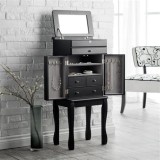Building a Base Cabinet for a Farmhouse Sink: Essential Aspects
Building a base cabinet for a farmhouse sink requires careful consideration of several essential aspects. These aspects ensure a sturdy and functional cabinet that complements the sink's design and provides ample storage space. We will delve into each aspect, highlighting its importance and how it contributes to the overall success of the project. ### 1. Material Selection: The choice of materials for the cabinet is crucial for its durability and aesthetics. The most common materials used are wood, plywood, and MDF. Wood provides a classic and durable option, while plywood offers strength and cost-effectiveness. MDF is a versatile and affordable material that can be painted or finished to match the décor. ### 2. Cabinet Dimensions: The dimensions of the cabinet should be carefully measured to accommodate the farmhouse sink. It should be wide enough to provide ample space around the sink, and deep enough to fit the under-sink plumbing and storage items. Proper measurements ensure a good fit and avoid any space constraints. ### 3. Cabinet Design: The design of the cabinet depends on personal preferences and the style of the kitchen. Farmhouse sinks typically require apron-front cabinets, which have a skirt-like design that conceals the sink's front. The cabinet can be designed to include drawers, shelves, or a combination of both to maximize storage space. ### 4. Sink Support: Adequate support for the farmhouse sink is essential to prevent sagging or damage. The cabinet should include a solid base and additional support brackets to distribute the weight of the sink evenly. Failure to provide proper support can lead to structural issues and potential leaks. ### 5. Plumbing Access: Installing a farmhouse sink requires access to the plumbing for connection to water supply lines and drainage. The cabinet should be designed to allow for easy access to the plumbing, either through removable panels or cutouts. Proper planning ensures efficient installation and maintenance of the plumbing system. ### 6. Ventilation: Ventilation is important for preventing moisture buildup in the cabinet, which can lead to mold or mildew. The cabinet should include vents or openings to allow air circulation and prevent trapped moisture. Proper ventilation ensures the longevity and durability of the cabinet and its contents. ### 7. Finishing Touches: The finishing touches include painting or staining the cabinet to match the kitchen décor, as well as installing door and drawer hardware. These elements enhance the aesthetic appeal and complement the overall style and design of the kitchen.
How To Build A Farmhouse Sink Base Cabinet Houseful Of Handmade

How To Build A Farmhouse Sink Base Cabinet Houseful Of Handmade

How To Build A Farmhouse Sink Base Cabinet Houseful Of Handmade

How To Build A Farmhouse Sink Base Cabinet Building Kitchen Installation

How To Build A Farmhouse Sink Base Cabinet Houseful Of Handmade

How To Add Vintage Charm With A Diy Reclaimed Wood Sink Cabinet The Created Home

How To Build A Farmhouse Sink Base Cabinet Houseful Of Handmade

Diy Budget Open Kitchen Cabinet You Can Build In A Weekend The Ponds Farmhouse

At Maple Grove How To Build A Support Structure For Farm House Sink Farmhouse Installation Kitchen Diy Apron Front

My So Called Diy Blog Resize Your Existing Cabinet And Doors To Fit An Apron Front Sink








